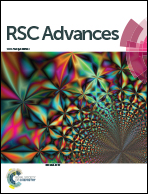Wheel like supramolecular assembly of cyclam decorated gold nanoparticles induced by Cd2+†
Abstract
This study presents a gold nanoparticle (Au NP) system based on interaction between cyclam and Au NPs. We have found that in the presence of Cd2+, cyclam coated Au NPs form well defined wheel like supramolecular assembled nanostructures. Self-assembly is achieved via co-ordination bonding between cyclam decorated Au NPs and Cd2+ ions. This finding introduces novel assembled nanostructures and contributes to understand the effect of Cd2+ cyclam interaction on the morphology of Au NPs assembly.


 Please wait while we load your content...
Please wait while we load your content...